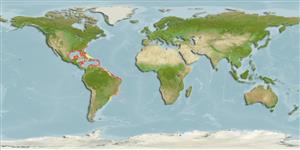Environment: milieu / climate zone / depth range / distribution range
Ecología
marino demersal; rango de profundidad 37 - 184 m (Ref. 3814). Tropical; 37°N - 34°S, 98°W - 34°W
Western Atlantic: North Carolina in USA to Brazil.
Tamaño / Peso / Age
Maturity: Lm ? range ? - ? cm
Short description
Morfología | Morfometría
Espinas dorsales (total): 19 - 21; Radios blandos dorsales (total): 33-40; Espinas anales 2; Radios blandos anales: 7 - 8; Vértebra: 25. The head of juveniles and young adults may have a large dark wedge-like spot above and behind orbits; black peritoneum; branchial cavity with black lining. Slender caudal peduncle. Head with ground color; irregular dark blotch on operculum. Body tan to dark brownish black. The dark band and stripe become less distinct in bigger specimens. Fins dark-colored (generally black).
Life cycle and mating behavior
Madurez | Reproducción | Puesta | Huevos | Fecundidad | Larva
Robins, C.R., R.M. Bailey, C.E. Bond, J.R. Brooker, E.A. Lachner, R.N. Lea and W.B. Scott, 1991. Common and scientific names of fishes from the United States and Canada. Am. Fish. Soc. Spec. Publ. (20):183 p. (Ref. 3814)
IUCN Red List Status (Ref. 130435)
Threat to humans
Harmless
Human uses
Más información
Age/SizeCrecimientoLength-weightLength-lengthLength-frequenciesMorfometríaMorfologíaLarvaDinámica larvariaReclutamientoAbundanciaBRUVS
ReferenciasAcuiculturaPerfil de acuiculturaRazasGenéticaElectrophoresesheritabilidadEnfermedadesProcesamientoNutrientsMass conversion
ColaboradoresImágenesStamps, Coins Misc.SonidosCiguateraVelocidadTipo de nataciónSuperficie branquialOtolitosCerebrosVisión
Herramientas
Special reports
Download XML
Fuentes de Internet
Estimates based on models
Preferred temperature (Ref.
123201): 17.7 - 27.1, mean 23.5 °C (based on 113 cells).
Phylogenetic diversity index (Ref.
82804): PD
50 = 0.5078 [Uniqueness, from 0.5 = low to 2.0 = high].
Bayesian length-weight: a=0.00851 (0.00413 - 0.01752), b=3.08 (2.91 - 3.25), in cm total length, based on LWR estimates for this (Sub)family-body shape (Ref.
93245).
Nivel trófico (Ref.
69278): 3.4 ±0.58 se; based on food items.
Resiliencia (Ref.
120179): Alto, población duplicada en un tiempo mínimo inferior a 15 meses (Preliminary K or Fecundity.).
Fishing Vulnerability (Ref.
59153): Low vulnerability (16 of 100).
